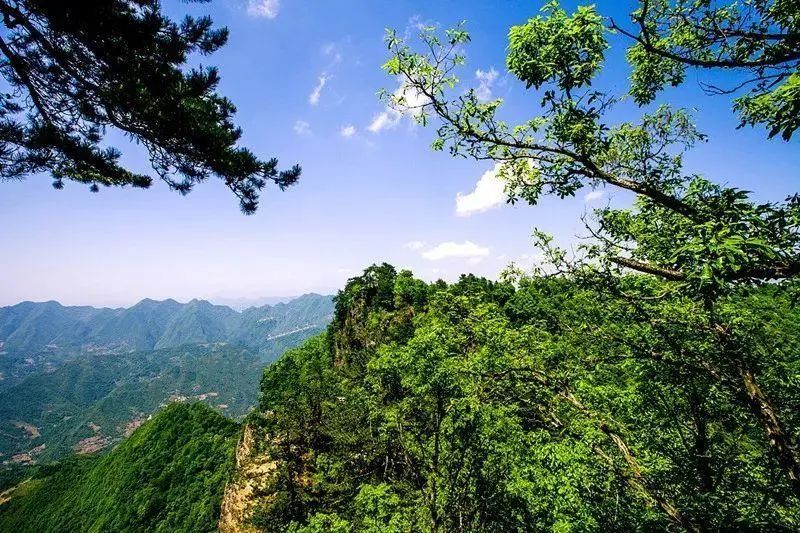Zushi Ridge, located in Sanjian Town on the southern outskirts of Lengshuijiang City in Hunan Province, spans an area of 12 square kilometers. Its main peak rises to an elevation of 1,072.3 meters, making it the highest point in the city.
The ridge stands tall and steep, with lush forests and bamboo groves at its foothills, where spring waters gurgle gently. Midway up the mountain, the wind rustles through pine trees, and clouds drift out from the valleys. At the summit, peculiar rock formations and steep cliffs abound. From the peak, on a clear day, one can see for miles, taking in the scenic beauty of central Hunan's mountains and rivers, with Changsha and Xiangtan faintly discernible in the distance.

Besides the renowned ancient temples and shrines that have made Zushi Ridge famous throughout central Hunan, the area boasts over 40 natural and cultural landscapes, including "Guanyin Sitting on a Lotus," "Toad Worshipping the Moon," "The Cowherd and the Weaver Girl," "Lion Guarding the Pond," "Azure Dragon Soaring," "Ganlu Pool," "Southern Heavenly Gate," "Dragon Whirl Rock," and "Wenjia Fortress."
Before liberation, Zushi Ridge served as a sacred Buddhist site for villagers from Lengshuijiang, Xinhua, Lianyuan, Xinshao, Shaoyang, Longhui, and other counties and cities, who came to pray, draw lots, and perform rituals to seek rain. Nowadays, the number of tourists flocking to the mountain for its fame continues to grow, with a steady stream of visitors on sunny days.
Zushi Hall
Zushi Ridge is home to several temples, with Zushi Hall being the most captivating.
The old hall at the summit was originally built in the 5th century AD, during the latter part of the Southern and Northern Dynasties, and has been preserved through successive renovations. Constructed against a cave, it covers an area of over 20 square meters.
The new hall, located about a mile below the old one, was first built in the first year of the Xuantong reign period in the late Qing Dynasty. Initially constructed by Wen Lunmou, a villager from beneath Sanjian Peak, his father, Wen Zhuowu, highly praised his son's bold endeavor. Despite being over ninety years old, he managed to climb the mountain with a cane to help his son determine the site for the hall, a story that has been passed down as an anecdote.
The Buddha statue enshrined in the new hall is said to have been sculpted by a Li family member from Shuitang. During the 40th year of the Qianlong reign, Li Zhengzhi, a wealthy local gentleman, had no sons in his middle age. Following the example of the story of the Holy Mother praying at Nishan, he went to Zushi Hall to pray for a son. His wish was granted, and he named his son Yinnan. Later, Yinnan passed the imperial examinations and was appointed as an official, eventually becoming the prefect of Luotai in Guangdong. In the Daoguang reign period, he resigned from his post and returned to his hometown, where he oversaw the compilation of the Xinhua County Annals. He specially wrote an essay to commemorate the event and had this statue sculpted to express his gratitude to the Buddha.
During the Anti-Japanese War, the new hall was renovated, expanding its area to over 200 square meters. As the saying goes, "A mountain need not be high; it is famous if it has a deity." Zushi Hall gained widespread fame, attracting a continuous stream of visitors, and the incense offerings at the Buddhist hall have remained uninterrupted through the ages.
Historical Legend
It is said that once a stone flew from the heavens and landed on the mountaintop. At that moment, the sky was ablaze with colorful lights, and people, marveling at the sight, regarded it as an auspicious omen. They invited craftsmen to carve the stone into a Buddha statue, known as Zushi, and built a temple to enshrine and worship it. The Buddha statue at Zushi Hall on Zushi Ridge is neither that of the Tathagata nor Guanyin, but rather a stone Buddha known as Zushi. In his later years, Li Citang, an imperial envoy and Hanlin scholar during the Bingxu year of the Daoguang reign, visited this place and composed the "Prayer to the Mountain Spirit," highly praising the site.

